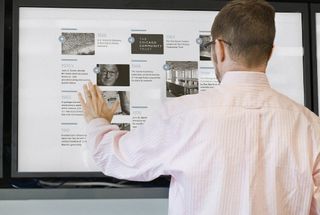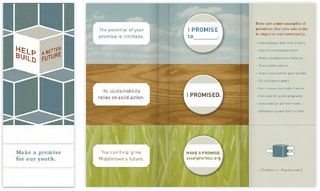Why you should design for nonprofits
Four leading creatives explain why socially responsible and non-profit design is as much about good business sense as it is good causes.
When Dawn Hancock decided to quit her job it was to concentrate on work she was passionate about. To focus on design that moved people. To found a studio that really made a difference. The creative had only ever come across the kind of projects she really wanted to be a part of as a volunteer designer, working with nonprofits. But, 15 years ago, that all changed.
"I never hated my day job," Hancock says. "I just wasn't passionate about the work I was doing. During that time, my father died unexpectedly, and that was the real motivation for me to quit. I found out that life was too short to do something you're not passionate about. And, knowing that design has the power to impact people, I made it my mission to focus solely on that type of work."
Working for Chicago
Hancock's dream came to fruition in the shape of multidisciplinary studio Firebelly, where she's partner and creative director. Committed to improving Chicago, and specifically its local community of Humboldt Park, Firebelly works with clients in both the for-profit and non-profit sectors, always under the same philosophy: Good Design for Good Reason.
The Chicago Community Trust offers grants to organisations working to improve the city. Firebelly gave the organisation its creative direction, from internal software and programmatic symbols to a series of interactive screens showcasing the trust's efforts and the donors who support them. This is smart, cutting-edge design and technology where you'd least expect to find it, but where it's most deserved.
Similarly, the City of Chicago offers rebates of up to 50 per cent to citizens making their gardens more sustainable. Originally, information on the Sustainable Backyards Program consisted of a few short paragraphs hidden within its vast website. That was until Firebelly gave it a rethink. Now residents can learn about native plants, use interactive maps to find supplies and track rebates through an easy-to-use online system.

New approach to non-paid
However, the initiative that best sums up the Firebelly ethos began a decade ago, when the studio decided to change the way it approaches non-paid projects.
Each year, nonprofits are invited to submit proposals to use the services of Firebelly and six other local companies for a full year. It's called the Grant for Good, and it affords the successful applicant the opportunity to completely reinvent itself - from branding and social media strategy through to copywriting and web development, and everything in between. The grant is valued at over $250,000.
Get the Creative Bloq Newsletter
Daily design news, reviews, how-tos and more, as picked by the editors.
Is it altruism?
Firebelly has built its reputation on these projects, earning global recognition in the process. So can this kind of work ever be considered truly altruistic, or does the creative freedom often on offer mean they're as attractive a proposition to studios as they are to clients?
"This type of question doesn't relate to Firebelly," Hancock says. "For a traditional business, perhaps taking on individual projects here and there for the opportunity to do something creative that they may not get the chance to do otherwise - maybe you're right. For us, no. We devote a whole year: that's a pretty big commitment to just get something 'cool' out of it."
The D&AD White Pencil - the prize that began in 2012 to reward creativity for social good - proves that many studios do indeed get something cool out of working for good causes. Whether their motives are selfless or not doesn't really matter, Gareth Howat argues. "For us, it's about creating strong ideas," Hat-Trick Design's founding partner says. "Of course, it makes you feel good that it's for a good cause, but we don't feel altruistic about that."
No to wackiness
The multidisciplinary design company's output for good causes includes the British Heart Foundation, Breakthrough Breast Cancer and Sumatran Orangutan Society. Howat says the studio doesn't differentiate these projects from any of its other clients.
"We didn't have a real strategy when it came to taking on these projects - other than if we thought the brief was right. Just because the budget is small doesn't mean the work can be wacky or self-indulgent; it still needs to be a clear idea to solve a problem or communicate a message."
Charity is outdated
Rama Gheerawo, the deputy director of Helen Hamlyn Centre for Design (HHC), agrees the idea of socially responsible design as charity is an outdated one. "The word charity is very loaded," he says, "for both the person giving the 'charity' and those receiving it. Socially driven projects work best when they're not just part of a charitable offer, but part of a business offer. We have been operating for over 20 years. Our projects are all socially centred and not part of a charitable programme."
Based at the Royal College of Art, London, HHC has worked in socially responsible design since 1991 - long before the term and others like it were in vogue. Its aim is to come up with research and practical projects demonstrating both the benefits and value of design as a tool for social change, and, ultimately, improving people's lives. Not just good intentions, but good business sense.
One current research theme looks at how people can become more central to their communities, while another considers how healthcare systems can sustainably and affordably provide the highest levels of clinical effectiveness, care and safety. A third asks how cities can be more inclusive of the needs of all their citizens, including older and low-income communities.
A fresh approach
"There's been a shift in how we approach our work," Rich Hollant says, "from measuring products sold, to measuring human and community impact. By focusing on doing right by people first and foremost, we now develop a different kind of relationship with our clients. We all work toward the same outcomes, with a deliberate and declared intention."
Hollant is lead strategist and a design director at Co:Lab. Until 2007, the US studio was part of a bigger team helping large corporate clients develop their brands and shift more units. Co:Lab now works to "contribute to social value" by partnering with various governments, foundations, nonprofits, social enterprises and corporations for the greater good.
A recent survey found 81 per cent of Connecticut's Middletown teens felt undervalued by their community - tied to an increase in "risky behaviour", such as substance abuse. Co:Lab worked with Middletown Youth Services Bureau to create a range of tools giving adults in the community the opportunity to participate in activities with local teens.
Bridging the generation gap
This project took the shape of a widespread print and digital campaign with a simple message: what seem to be extremely complex issues can often be rectified by communication and common sense. It was really about bridging the generational gap, and this required a clear visual language that appealed to all ages.

When Co:Lab changed the kind of work it was undertaking, there was a shift in the traditional studio-client dynamic. Hollant says that now, more than ever before, the studio shares the same goals as its clients, and is more invested in the outcome of projects. Success is measured on a long-term basis - in years and decades rather than quarters and financial years.
Because budgets can be pretty tight - if not non-existent - when working with nonprofits, there's often more at stake. This means lots of pressure, very short deadlines, little room for error and, perhaps surprisingly, exacting clients. "We are a demanding firm working on tough issues. We believe that demanding people make things better, so we love demanding clients and recommend embracing those relationships," he says.
How to get involved
Hollant, like all the creatives we spoke with, encourages anyone thinking of working with socially responsible design to get involved. Pro bono is great but not the only route to take. Design for good causes - causes you care about - is as much about responsibility as it is charity. But there's no reason why it shouldn't be part of a sound business offer rather than a handout. Making a living and helping good causes needn't be mutually exclusive. And these types of projects certainly shouldn't be taken advantage of as a creative outlet.
"We made the shift to working on social profit initiatives for two main reasons," Hollant says. "To bring more meaning to the work we were already doing, and to facilitate our involvement in deeper, long-term relationships. I worry when I hear folks who are so unhappy with their day-to-day work have to give their talents away to feel fulfilled. It breaks my heart for all involved.
"To us, the quality of work is a by-product of the process. Alongside staying within the budget and agreed timeline, it's the cost of entry for being a designer. It's not a perk of the job; it's the chassis on which the job is built."
Words: Gary Evans
This article originally appeared in Computer Arts issue 219.
Liked this? Read these!
- Create a perfect mood board with these pro tips
- The ultimate guide to logo design
- Useful and inspiring flyer templates
Have you done any work for nonprofits? Tell us in the comments!

Thank you for reading 5 articles this month* Join now for unlimited access
Enjoy your first month for just £1 / $1 / €1
*Read 5 free articles per month without a subscription

Join now for unlimited access
Try first month for just £1 / $1 / €1
The Creative Bloq team is made up of a group of design fans, and has changed and evolved since Creative Bloq began back in 2012. The current website team consists of eight full-time members of staff: Editor Georgia Coggan, Deputy Editor Rosie Hilder, Ecommerce Editor Beren Neale, Senior News Editor Daniel Piper, Editor, Digital Art and 3D Ian Dean, Tech Reviews Editor Erlingur Einarsson and Ecommerce Writer Beth Nicholls and Staff Writer Natalie Fear, as well as a roster of freelancers from around the world. The 3D World and ImagineFX magazine teams also pitch in, ensuring that content from 3D World and ImagineFX is represented on Creative Bloq.
